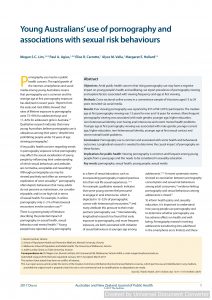Rates, Age, & Impact of Exposure to Pornography
Young Australians’ Use of Pornography and Associations with Sexual Risk Behaviours
 Full Article Name: Young Australians’ Use of Pornography and Associations with Sexual Risk Behaviours
Full Article Name: Young Australians’ Use of Pornography and Associations with Sexual Risk Behaviours
Open Access: Yes
Abstract
Objectives: Amid public health concern that rising pornography use may have a negative impact on young people’s health and wellbeing, we report prevalence of pornography viewing and explore factors associated with viewing frequency and age at first viewing. Methods: Cross‐sectional online survey in a convenience sample of Victorians aged 15 to 29 years recruited via social media. Results: Ever viewing pornography was reported by 815 of 941 (87%) participants. The median age at first pornography viewing was 13 years for men and 16 years for women. More frequent pornography viewing was associated with male gender, younger age, higher education, non‐heterosexual identity, ever having anal intercourse and recent mental health problems. Younger age at first pornography viewing was associated with male gender, younger current age, higher education, non‐heterosexual identity, younger age at first sexual contact and recent mental health problems. Conclusions: Pornography use is common and associated with some health and behavioural outcomes. Longitudinal research is needed to determine the causal impact of pornography on these factors. Implications for public health: Viewing pornography is common and frequent among young people from a young age and this needs to be considered in sexuality education.
Citation
Lim, M. S., Agius, P. A., Carrotte, E. R., Vella, A. M., & Hellard, M. E. (2017), Young Australians’ use of pornography and associations with sexual risk behaviours. Australian and New Zealand Journal of Public Health, 41, 438-443. https://doi.org/10.1111/1753-6405.12678

